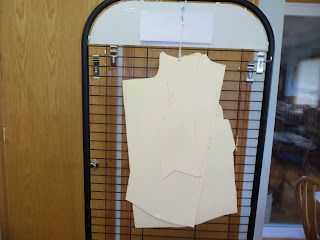How to Keep Your Favorite Patterns in Good Shape
Do you get tired of trying to
refold your patterns and get them to fit back into a pattern envelope? I do.
Also, after I make several articles from the pattern, the pieces become
wrinkled, tattered, and distorted. To
avoid these things, I take my favorite patterns (those I know fit me) and
transfer them to tag board.
I do not like to waste a
pattern, so I always transfer it to medical paper before using it the first
time. Medical paper is the paper your
doctor uses on the examining table. I
usually need to alter any pattern I make, so this paper is a good choice
because it is inexpensive and is easy to see through for tracing. Once I have the pattern made, I will cut the
fabric and make a trial garment. After I
get it to fit the way I want, then I transfer the pattern to tag board. I cut all the pieces out, label them, attach
them to a pattern hook and place them in a spare closet or on a clothes rack. No folding needed. They are ready for me the next time I want to
make that garment.
The following is a list of supplies you need to transfer your pattern to tag board:
tag board
notcher
awl
tracing wheel with sharp spikes
hole punch
pattern hanger
Tag board is sometimes called
oak tag. It is similar to the paper used
to make manila file folders. I purchased
my tag board from Amazon.com in a large roll that is 58 inches wide, but I do
not recommend you do that unless you don’t mind paying a large freight bill and
getting a life time supply. Amazon and other companies sell large sheets
of tag board in varying quantities and if you have Prime membership, it may
ship for free. Even Walmart.com sells sheets
of tag board. Just make sure the sheets
are large enough to trace the individual pieces of your pattern.
I use
a notcher to mark the notches on the pattern. The notcher is also handy to use to mark the
beginning of darts and other things such as pleats of tucks. I use a tracing wheel with sharp spikes to
transfer markings such as darts. Then I
can see the small indentations on the tag board and can mark the dart with a
pen or pencil. I also use an awl to mark things like the bust
point.
Most people trace the pattern
pieces onto the tag board with no seam allowances. That way, when you trace the pattern onto
your fabric you have the precise sewing lines and then you add the seam
allowances before cutting the fabric. I
have not been doing that. Instead, I
trace the pattern with the seam allowance included before I transfer it to the
tag board. The next pattern I trace onto
tag board, I intend to do it without the seam allowance and see how I like that
method. You can use a fabric marker or
a chalk marker to trace the tag board pattern piece onto the fabric. I prefer to use the chalk marker.
After your tag board pattern
pieces are cut out, punch a hole in the top of each piece and place all of them
onto a pattern hook. The pattern hooks
can be purchased at Amazon or other online companies. Now your favorite pattern is ready for the
next garment without trying to unfold and press it to get it ready to be
used.
There are lots of different
kinds of paper or other material that can be used to trace patterns. I am just sharing with you the method I like
for keeping my favorite patterns. If I
don’t plan to make more than a couple of garments from a pattern, I don’t
transfer it to tag board.
Good luck with all your sewing
projects!
Judy



No comments:
Post a Comment